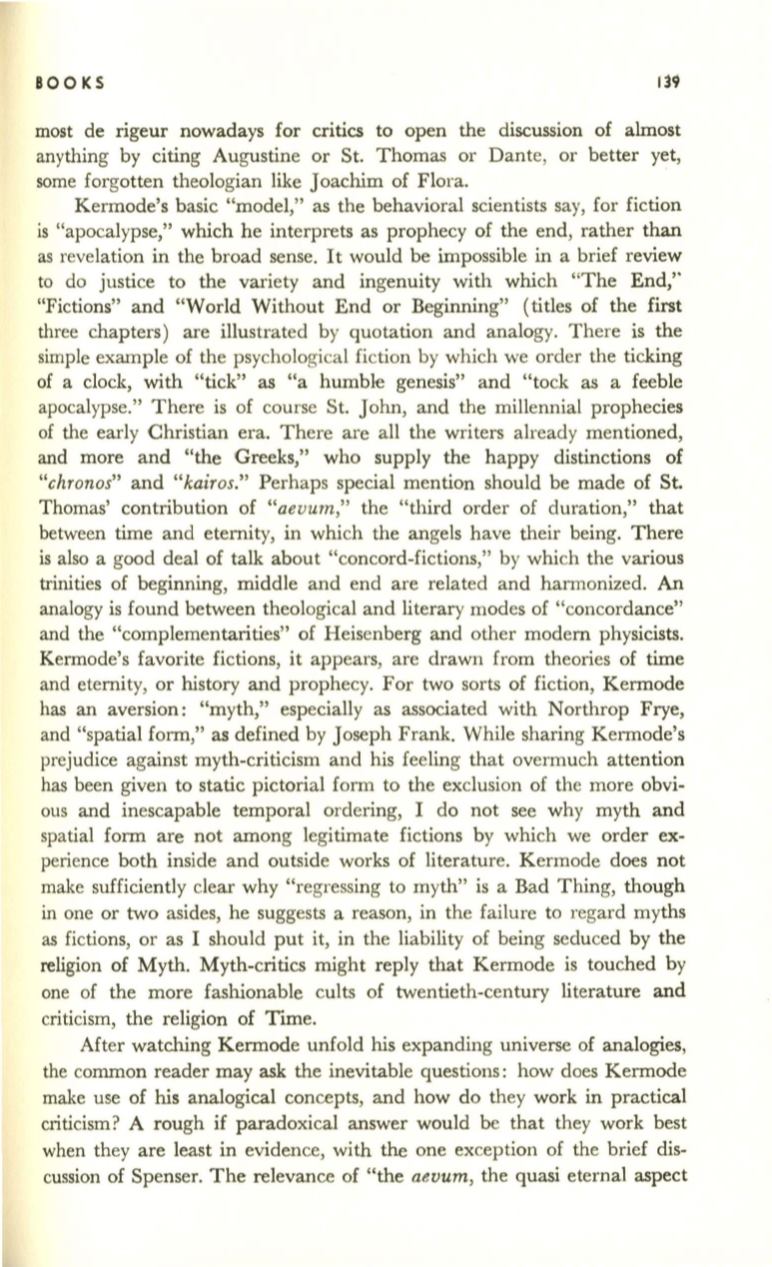
BOOKS
139
most de rigeur nowadays for critics to open the discussion of almost
anything by citing Augustine or St. Thomas or Dante, or better yet,
some forgotten theologian like Joachim of Flora.
Kermode's basic "model," as the behavioral scientists say, for fiction
is "apocalypse," which he interprets as prophecy of the end, rather than
as revelation in the broad sense. It would be impossible in a brief review
to do justice to the variety and ingenuity with which "The End,"
"Fictions" and "World Without End or Beginning" (titles of the
first
three chapters) are illustrated by quotation and analogy. There is the
simple example of the psychological fiction by which we order the ticking
of a clock, with "tick" as "a humble genesis" and "tock as a feeble
apocalypse." There is of course St. John, and the millennial prophecies
of the early Christian era. There are all the writers already mentioned,
and more and "the Greeks," who supply the happy distinctions of
"chronos"
and
"kairos."
Perhaps special mention should be made of St.
Thomas' contribution of
"aevum,"
the "third order of duration," that
between time and eternity, in which the angels have their being. There
is also a good deal of talk about "concord-fictions," by which the various
trinities of beginning, middle and end are related and harmonized.
An
analogy is found between theological and literary modes of "concordance"
and the "complementarities" of Heisenberg and other modem physicists.
Kermode's favorite fictions, it appears, are drawn from theories of time
and eternity, or history and prophecy. For two sorts of fiction, Kermode
has an aversion: "myth," especially as associated with Northrop Frye,
and "spatial form," as defined by Joseph Frank. While sharing Kermode's
prejudice against myth-criticism and his feeling that overmuch attention
has
been given to static pictorial form to the exclusion of the more obvi–
ous and inescapable temporal ordering, I do not see why myth and
spatial form are not among legitimate fictions by which we order ex–
perience both inside and outside works of literature. Kermode does not
make sufficiently clear why "regressing to myth" is a Bad Thing, though
in
one or two asides, he suggests a reason, in the failure to regard myths
as fictions, or as I should put it, in the liability of being seduced by the
religion of Myth. Myth-critics might reply that Kermode is touched by
one of the more fashionable cults of twentieth-century literature and
criticism, the religion of Time.
After watching Kermode unfold his expanding universe of analogies,
the common reader may
ask
the inevitable questions: how does Kermode
make use of his analogical concepts, and how do they work in practical
criticism? A rough if paradoxical answer would
be
that they work best
when they are least in evidence, with
the
one exception of the brief dis–
cussion of Spenser. The relevance of "the
aevum,
the quasi eternal aspect


